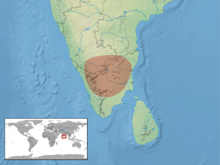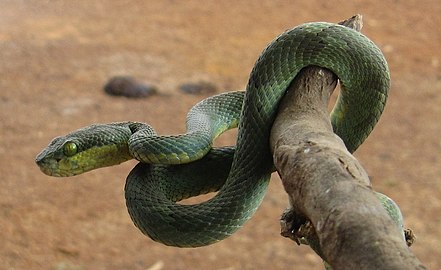Craspedocephalus gramineus
| Craspedocephalus gramineus | |
|---|---|

| |
| Scientific classification | |
| Domain: | Eukaryota |
| Kingdom: | Animalia |
| Phylum: | Chordata |
| Class: | Reptilia |
| Order: | Squamata |
| Suborder: | Serpentes |
| Family: | Viperidae |
| Genus: | Craspedocephalus |
| Species: | C. gramineus
|
| Binomial name | |
| Craspedocephalus gramineus (Shaw, 1802)
| |

| |
| Synonyms[2] | |
| |

Craspedocephalus gramineus, known as the bamboo pit viper, Indian green pit viper, or common green pit viper,[3] is a venomous pit viper species found in the southern and north eastern parts of India. No subspecies are currently recognized.
Description[edit]
The rostral scale is as deep as broad or broader than deep. The upper head-scales are small, smooth, imbricate; supraocular scale narrow, rarely broken up. The internasals are contact or separated by one or two scales. There are 8 to 13 scales on a line between the supraoculars; usually one or two, rarely three, series of scales between the suboculars and the labials; 9 to 12 upper labials, second usually forming the anterior border of the loreal pit, third largest; temporal scales smooth. The dorsal scales are more or less distinctly keeled, in 21 (rarely 19 or 23) rows; ventrals 145–175; anal scale entire; subcaudals in two rows 53–76.
The upper parts are usually bright green, rarely yellowish, greyish, or purplish brown, with or without black, brown, or reddish spots; usually a light, white, yellow, or red streak along the outer row of scales; end of tail frequently yellow or red; lower parts green, yellow, or whitish.[4]
It grows to a total length of 3.25 feet (0.99 m). The tail is 5.5 inches (14 cm) in length.[4]
-
Head
-
In Raajmachi, Lonavala
-
In Satara, Maharashtra
Taxonomy and common names[edit]
It was first described in 1802 as Coluber graminaeus.[2] No subspecies are recognized.[5][2]
Common names include: bamboo pit viper,[6][7] Indian tree viper,[8] bamboo snake, Indian green tree viper, green tree viper,[9] bamboo viper,[10] bamboo pitviper,[11] boodro pam, grass-green snake,[12] and green pit viper.[13]
Geographic range[edit]
The Bamboo Pit Viper is a widespread species throughout the peninsular India. It is also found albeit very scarcely in the eastern region of India spanning from Odisha, Jharkhand, and West Bengal.[citation needed]
The type locality is "Vizagapatam, India", which is based on Russell (1796).[14]
Habitat[edit]
Despite its name, the species is not particularly associated to Bamboo thickets. It is an arboreal snake, usually found on low to medium high bushes and trees, and often near streams.[13] Being a nocturnal creature, it is found at lower heights as it sits in ambush at night. During daytime, these snakes ascend at greater heights.
Behaviour[edit]
C. gramineus is arboreal and nocturnal. When threatened, it is aggressive and does not hesitate to bite.[13] The venom is hemotoxic and neurotoxic.[citation needed]
Diet[edit]
It feeds on lizards, rats and birds.[13]
Reproduction[edit]
C. gramineus is ovoviviparous. Adult females gives birth to 6 to 11 young, which measure up to 4.5 in (110 mm) in length.[citation needed]
References[edit]
- ^ Srinivasulu, C.; Srinivasulu, B.; Deepak, V.; Achyuthan, N.S.; Das, A.; Kulkarni, N.U. (2013). "Trimeresurus gramineus". IUCN Red List of Threatened Species. 2013: e.T178245A1528655. doi:10.2305/IUCN.UK.2013-1.RLTS.T178245A1528655.en. Retrieved 19 November 2021.
- ^ a b c Trimeresurus gramineus at the Reptarium.cz Reptile Database. Accessed 21 January 2019.
- ^ "Our Mission is to conserve snakes in their natural habitat and reduce human mortality due to snake bites through research, education & outreach activities".
- ^ a b Boulenger GA. 1890. The Fauna of British India, Including Ceylon and Burma. Reptilia and Batrachia. Secretary of State for India in Council. (Taylor and Francis, Printers.) London. xviii + 541 pp. (Trimeresurus, p. 425 & Trimeresurus gramineus, pp. 429–430.)
- ^ "Trimeresurus gramineus". Integrated Taxonomic Information System. Retrieved 27 September 2006.
- ^ Khaire, N. 2006. A Guide to the Snakes of Maharashtra, Goa and Karnataka. Indian Herpetological Society. Pune, India. (Photographic guide with 61 species.)
- ^ Smith MA. 1943. The Fauna of British India, Ceylon and Burma, Including the Whole of the Indo-Chinese Sub-region. Reptilia and Amphibia. Vol. III. – Serpentes. Secretary of State for India. (Taylor & Francis, Printers). London. xii + 583 pp., 166 figures. (Trimeresurus gramineus, pp. 515–517, Fig. 164.)
- ^ Mehrtens JM. 1987. Living Snakes of the World in Color. New York: Sterling Publishers. 480 pp. ISBN 0-8069-6460-X.
- ^ U.S. Navy. 1991. Poisonous Snakes of the World. US Govt. New York: Dover Publications Inc. 203 pp. ISBN 0-486-26629-X.
- ^ Parker HW, Grandison AGC. 1977. Snakes – a natural history. Second Edition. British Museum (Natural History) and Cornell University Press. 108 pp. 16 plates. LCCCN 76-54625. ISBN 0-8014-1095-9 (cloth), ISBN 0-8014-9164-9 (paper).
- ^ Gumprecht A, Tillack F, Orlov NL, Captain A, Ryabov S. 2004. Asian Pitvipers. GeitjeBooks Berlin. 1st Edition. 368 pp. ISBN 3-937975-00-4.
- ^ Shaw. 1802. p. 420.
- ^ a b c d Das, Indraneil. 2002. A Photographic Guide to Snakes and Other Reptiles of India. Ralph Curtis Books. Sanibel Island, Florida. 144 pp. ISBN 0-88359-056-5. (Trimeresurus gramineus, p. 65.)
- ^ McDiarmid RW, Campbell JA, Touré T. 1999. Snake Species of the World: A Taxonomic and Geographic Reference, Volume 1. Herpetologists' League. 511 pp. ISBN 1-893777-00-6 (series). ISBN 1-893777-01-4 (volume).
Further reading[edit]
- Cantor, T.E. 1839. Spicilegium serpentium indicorum [parts 1 and 2]. Proc. Zool. Soc. London 7: 31–34, 49–55.
- Gumprecht, A.; Tillack, F.; Orlov, N.L.; Captain, A. & Ryabow, S. 2004. Asian Pit Vipers. Geitje Books. Berlin. 368 pp.
- Russell, P. 1796. An Account of Indian Serpents, Collected on the Coast of Coromandel; Containing Descriptions and Drawings of Each Species, Together with Experiments and Remarks on Their Several Poisons. George Nicol. London. viii + 91 pp. + Plates I.- XLVI.
- Shaw, G. 1802. General Zoology, or Systematic Natural History: Vol. III., Part II. G. Kearsley. (Thomas Davison, Printer). London. iv + pp. 313–615 + Plates 87–140. ("Coluber Gramineus", pp. 420–421.).
- Stejneger, L. 1927. The green pit viper, Trimeresurus gramineus, in China. Proceedings of the United States National Museum 72 (19): 1–10.




